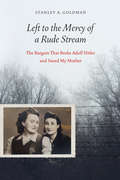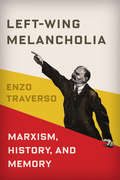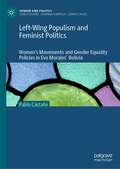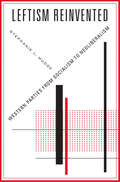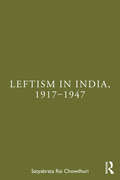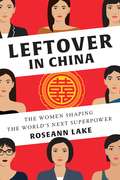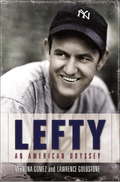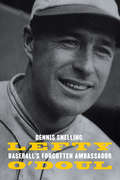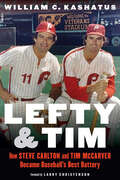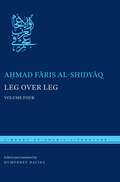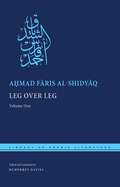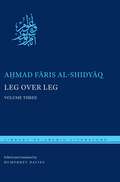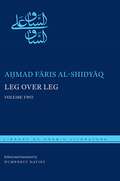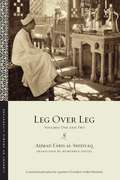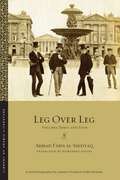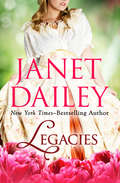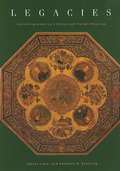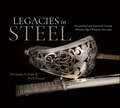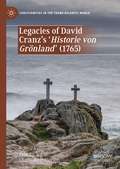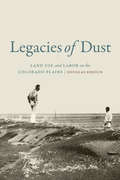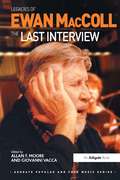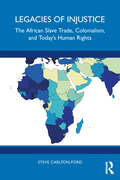- Table View
- List View
Left to the Mercy of a Rude Stream: The Bargain That Broke Adolf Hitler and Saved My Mother
by Stanley A. GoldmanSeven years after the death of his mother, Malka, Stanley A. Goldman traveled to Israel to visit her best friend during the Holocaust. The best friend’s daughter showed Goldman a pamphlet she had acquired from the Israeli Holocaust Museum that documented activities of one man’s negotiations with the Nazi’s interior minister and SS head, Heinrich Himmler, for the release of the Jewish women from the concentration camp at Ravensbrück. While looking through the pamphlet, the two discovered a picture that could have been their mothers being released from the camp. Wanting to know the details of how they were saved, Goldman set out on a long and difficult path to unravel the mystery. After years of researching the pamphlet, Goldman learned that a German Jew named Norbert Masur made a treacherous journey from the safety of Sweden back into the war zone in order to secure the release of the Jewish women imprisoned at the Ravensbrück concentration camp. Masur not only succeeded in his mission against all odds but he contributed to the downfall of the Nazi hierarchy itself. This amazing, little-known story uncovers a piece of history about the undermining of the Nazi regime, the women of the Holocaust, and the strained but loving relationship between a survivor and her son.
Left-Wing Melancholia: Marxism, History, and Memory (New Directions in Critical Theory #17)
by Enzo TraversoThe fall of the Berlin Wall marked the end of the Cold War but also the rise of a melancholic vision of history as a series of losses. For the political left, the cause lost was communism, and this trauma determined how leftists wrote the next chapter in their political struggle and how they have thought about their past since. Throughout the twentieth century, argues Left-Wing Melancholia, from classical Marxism to psychoanalysis to the advent of critical theory, a culture of defeat and its emotional overlay of melancholy have characterized the leftist understanding of the political in history and in theoretical critique.Drawing on a vast and diverse archive in theory, testimony, and image and on such thinkers as Karl Marx, Walter Benjamin, Theodor W. Adorno, and others, the intellectual historian Enzo Traverso explores the varying nature of left melancholy as it has manifested in a feeling of guilt for not sufficiently challenging authority, in a fear of surrendering in disarray and resignation, in mourning the human costs of the past, and in a sense of failure for not realizing utopian aspirations. Yet hidden within this melancholic tradition are the resources for a renewed challenge to prevailing regimes of historicity, a passion that has the power to reignite the dialectic of revolutionary thought.
Left-Wing Populism and Feminist Politics: Women’s Movements and Gender Equality Policies in Evo Morales’ Bolivia (Gender and Politics)
by Pablo CastañoThis book investigates the relation between left-wing populism and feminist politics by analysing three specific aspects. First, whether left-wing populist parties promote gender equality policies, against charges of a general inconsistency between both political projects; Second, how do these parties form their policy-making coalitions in the field of gender equality; Third, how much impact on policy do women’s movements have when left-wing populists are in power. The book is focused on the case of Bolivia during the first twelve years of Evo Morales's presidency. The empirical analysis is based on the qualitative content analysis of documents and semi-structured interviews with women’s movements’ activists, policy-makers and experts in women’s movements. The central issue of the book is present throughout the volume, but each empirical chapter can be also read as a semi-autonomous analysis of a specific aspect of the relation between left-wing populism and feminist politics, which increases the interest of the book for different audiences including experts in gender and politics and feminist activists, specialists in Latin American politics, indigenous politics and social movements.
Leftism Reinvented: Western Parties from Socialism to Neoliberalism
by Stephanie L. MudgeLeft-leaning political parties play an important role as representatives of the poor and disempowered. They once did so by promising protections from the forces of capital and the market’s tendencies to produce inequality. But in the 1990s they gave up on protection, asking voters to adapt to a market-driven world. Meanwhile, new, extreme parties began to promise economic protections of their own—albeit in an angry, anti-immigrant tone. To better understand today’s strange new political world, Stephanie L. Mudge’s Leftism Reinvented analyzes the history of the Swedish and German Social Democrats, the British Labour Party, and the American Democratic Party. Breaking with an assumption that parties simply respond to forces beyond their control, Mudge argues that left parties’ changing promises expressed the worldviews of different kinds of experts. To understand how left parties speak, we have to understand the people who speak for them. Leftism Reinvented shows how Keynesian economists came to speak for left parties by the early 1960s. These economists saw their task in terms of discretionary, politically-sensitive economic management. But in the 1980s a new kind of economist, who viewed the advancement of markets as left parties’ main task, came to the fore. Meanwhile, as voters’ loyalties to left parties waned, professional strategists were called upon to “spin” party messages. Ultimately, left parties undermined themselves, leaving a representative vacuum in their wake. Leftism Reinvented raises new questions about the roles and responsibilities of left parties—and their experts—in politics today.
Leftism in India, 1917–1947
by Satyabrata Rai ChowdhuriThis book provides a comprehensive account of the Leftist movements in India during the most decisive phase of its struggle for freedom. It also describes how the Leftist movements interacted with the mainstream Indian freedom movement led by the Indian National Congress, guided by Mohandas Karamchand Gandhi and his ideology of non-violence. This ideology directly opposed those who believed in Marxism-Leninism and, naturally, their policies clashed at almost every stage of the freedom movement. These clashes gave rise to dramatic developments, which have been described in this book in their proper context and analysed with scholarly objectivity.The book traces the early twentieth-century socio-political awakening of the bourgeois-democratic class of Indian society, the rise of Left-wing nationalists following the Swadeshi Movement, the activities of the early revolutionaries and the formation of the Communist Party of India abroad, the growth of communism in India, the growth of the Left wing within the Indian National Congress (known as the Congress socialists) and other Left parties, and various labour and peasant movements.The book will be useful to the students, researchers and teachers of Political Science, History and South Asian Studies. Readers with an interest in South Asian politics and anyone wishing to gain a thorough understanding of the origin of the Left in India will also find the book interesting.
Leftover in China: The Women Shaping The World's Next Superpower
by Roseann LakeFactory Girls meets The Vagina Monologues in this fascinating narrative on China’s single women—and why they could be the source of its economic future. Forty years ago, China enacted the one-child policy, only recently relaxed. Among many other unintended consequences, it resulted in both an enormous gender imbalance—with a predicted twenty million more men than women of marriage age by 2020—and China’s first generations of only-daughters. Given the resources normally reserved for boys, these girls were pushed to study, excel in college, and succeed in careers, as if they were sons. Now living in an economic powerhouse, enough of these women have decided to postpone marriage—or not marry at all—to spawn a label: "leftovers." Unprecedentedly well-educated and goal-oriented, they struggle to find partners in a society where gender roles have not evolved as vigorously as society itself, and where new professional opportunities have made women less willing to compromise their careers or concede to marriage for the sake of being wed. Further complicating their search for a mate, the vast majority of China’s single men reside in and are tied to the rural areas where they were raised. This makes them geographically, economically, and educationally incompatible with city-dwelling “leftovers,” who also face difficulty in partnering with urban men, given the urban men’s general preference for more dutiful, domesticated wives. Part critique of China’s paternalistic ideals, part playful portrait of the romantic travails of China’s trailblazing women and their well-meaning parents who are anxious to see their daughters snuggled into traditional wedlock, Roseann Lake’s Leftover in China focuses on the lives of four individual women against a backdrop of colorful anecdotes, hundreds of interviews, and rigorous historical and demographic research to show how these "leftovers" are the linchpin to China’s future.
Lefty
by Lawrence Goldstone Vernona GomezA baseball legend distinguished by his competitive nature, quick wit, and generous spirit, Lefty Gomez was one of a kind. Told for the first time, this is his remarkable story. Born to a small-town California ranching family, the youngest of eight, Vernon "Lefty" Gomez rode his powerful arm and jocular personality right across America to the dugout of the New York Yankees. Lefty baffled hitters with his blazing fastball, establishing himself as the team's ace. He vacationed with Babe Ruth, served as Joe DiMaggio's confidant, and consoled Lou Gehrig the day the "Iron Horse" removed himself from the lineup. He started and won the first-ever All-Star Game, was the first pitcher to make the cover of Time magazine, and barnstormed Japan as part of Major League Baseball's grand ambassadorial tour in 1934. Away from the diamond, Lefty played the big-city bon vivant, marrying Broadway star June O'Dea and hobnobbing with a who's who of celebrities, including George Gershwin, Jack Dempsey, Ernest Hemingway, Marilyn Monroe, George M. Cohan, and James Michener. He even scored a private audience with the pope. And even when his pro ball career was done, Lefty wasn't. He became a national representative for Wilson Sporting Goods, logging over 100,000 miles a year, spreading the word about America's favorite game, and touching thousands of lives. In 1972 he was inducted into the National Baseball Hall of Fame. Three baseball fields are named for him, and to this day the top honor bestowed each year by the American Baseball Coaches Association is the Lefty Gomez Award. Now, drawing on countless conversations with Lefty, interweaving more than three hundred interviews conducted with his family, friends, competitors, and teammates over the course of a decade, and revealing candid photos, documents, and film clips--many never shown publicly--his daughter Vernona Gomez and her award-winning co-author Lawrence Goldstone vividly re-create the life and adventures of the irreverent southpaw fondly dubbed "El Señor Goofy." "I'd rather be lucky than good," Lefty Gomez once quipped--one of many classic one-liners documented here. In the end he was both. A star-studded romp through baseball's most glorious seasons and America's most glamorous years, Lefty is at once a long-overdue reminder of a pitcher's greatness and a heartwarming celebration of a life well-lived.
Lefty O'Doul: Baseball's Forgotten Ambassador
by Dennis SnellingFrom San Francisco to the Ginza in Tokyo, Lefty O’Doul relates the untold story of one of baseball’s greatest hitters, most colorful characters, and the unofficial father of professional baseball in Japan. Lefty O’Doul (1897–1969) began his career on the sandlots of San Francisco and was drafted by the Yankees as a pitcher. Although an arm injury and his refusal to give up the mound clouded his first four years, he converted into an outfielder. After four Minor League seasons he returned to the Major Leagues to become one of the game’s most prolific power hitters, retiring with the fourth-highest lifetime batting average in Major League history. A self-taught “scientific” hitter, O’Doul then became the game’s preeminent hitting instructor, counting Joe DiMaggio and Ted Williams as his top disciples. In 1931 O’Doul traveled to Japan with an All-Star team and later convinced Babe Ruth to headline a 1934 tour. By helping to establish the professional game in Japan, he paved the way for Hideo Nomo, Ichiro Suzuki, and Hideki Matsui to play in the American Major Leagues. O’Doul’s finest moment came in 1949, when General Douglas MacArthur asked him to bring a baseball team to Japan, a tour that MacArthur later praised as one of the greatest diplomatic efforts in U.S. history. O’Doul became one of the most successful managers in the Pacific Coast League and was instrumental in spreading baseball’s growth and popularity in Japan. He is still beloved in Japan, where in 2002 he was inducted into the Japanese Baseball Hall of Fame.
Lefty and Tim: How Steve Carlton and Tim McCarver Became Baseball's Best Battery
by William C. KashatusLefty and Tim is the dual biography of Hall of Fame pitcher Steve &“Lefty&” Carlton and catcher Tim McCarver, detailing their relationship from 1965, when they played with the St. Louis Cardinals, through 1980, when they played for the Philadelphia Phillies. Along the way McCarver became Carlton&’s personal catcher, and together they became the best battery in baseball in the mid-to-late 1970s. At first glance Carlton and McCarver appear like an odd couple: McCarver was old school, Carlton new age. At the beginning of his career, McCarver believed that the catcher called the pitches, encouraged the pitcher when necessary, and schooled the pitcher when he deviated from the game plan. But Lefty, who pioneered the use of meditation and martial arts in baseball, was stubborn too. He wanted to control pitch selection. Over time, Carlton and McCarver developed a strong bond off the diamond that allowed them to understand and trust each other. In the process, Steve Carlton became one of the greatest left-handers in the history of Major League Baseball, an achievement that would not have been possible without Tim McCarver as his catcher. Not only did McCarver mentor Carlton as a young hurler with the Cardinals, but he helped resurrect Carlton&’s career when they were reunited in Philadelphia midseason in 1975. Carlton won his second Cy Young Award with McCarver behind the plate in 1977. Told in the historical context of the time they played the game, Lefty and Tim recounts the pair&’s time in the tumultuous sixties, with the racial integration of the St. Louis Cardinals and the dominance of pitching, and in the turbulent seventies, characterized by MLB&’s labor tensions, the arrival of free agency, and the return of the lively ball that followed the lowering of the pitcher&’s mound in 1969.
Leg over Leg: Volume Four (Library of Arabic Literature #30)
by Aḥmad Fāris al-ShidyāqFinalist for the 2016 National Translation Award given by the American Literary Translators' AssociationThe life, birth, and early years of 'the Fariyaq'—the alter ego of the Arab intellectual Ahmad Faris al-ShidyaqLeg over Leg recounts the life, from birth to middle age, of ‘the Fariyaq,’ alter ego of Ahmad Faris al-Shidyaq, a pivotal figure in the intellectual and literary history of the modern Arab world. The always edifying and often hilarious adventures of the Fariyaq, as he moves from his native Lebanon to Egypt, Malta, Tunis, England and France, provide the author with grist for wide-ranging discussions of the intellectual and social issues of his time, including the ignorance and corruption of the Lebanese religious and secular establishments, freedom of conscience, women’s rights, sexual relationships between men and women, the manners and customs of Europeans and Middle Easterners, and the differences between contemporary European and Arabic literatures. Al-Shidyaq also celebrates the genius and beauty of the classical Arabic language.Akin to Sterne and Rabelais in his satirical outlook and technical inventiveness, al-Shidyaq produced in Leg over Leg a work that is unique and unclassifiable. It was initially widely condemned for its attacks on authority, its religious skepticism, and its “obscenity,” and later editions were often abridged. This is the first English translation of the work and reproduces the original Arabic text, published under the author’s supervision in 1855.
Leg over Leg: Volume One (Library of Arabic Literature #6)
by Aḥmad Fāris al-ShidyāqFinalist for the 2016 National Translation Award given by the American Literary Translators' AssociationThe life, birth, and early years of 'the Fariyaq'—the alter ego of the Arab intellectual Ahmad Faris al-ShidyaqLeg over Leg recounts the life, from birth to middle age, of ‘the Fariyaq,’ alter ego of Ahmad Faris al-Shidyaq, a pivotal figure in the intellectual and literary history of the modern Arab world. The always edifying and often hilarious adventures of the Fariyaq, as he moves from his native Lebanon to Egypt, Malta, Tunis, England and France, provide the author with grist for wide-ranging discussions of the intellectual and social issues of his time, including the ignorance and corruption of the Lebanese religious and secular establishments, freedom of conscience, women’s rights, sexual relationships between men and women, the manners and customs of Europeans and Middle Easterners, and the differences between contemporary European and Arabic literatures. Al-Shidyaq also celebrates the genius and beauty of the classical Arabic language.Akin to Sterne and Rabelais in his satirical outlook and technical inventiveness, al-Shidyaq produced in Leg Over Leg a work that is unique and unclassifiable. It was initially widely condemned for its attacks on authority, its religious skepticism, and its “obscenity,” and later editions were often abridged. This is the first English translation of the work and reproduces the original Arabic text, published under the author’s supervision in 1855.
Leg over Leg: Volume Three (Library of Arabic Literature #34)
by Aḥmad Fāris al-ShidyāqFinalist for the 2016 National Translation Award given by the American Literary Translators' AssociationThe life, birth, and early years of 'the Fariyaq'—the alter ego of the Arab intellectual Ahmad Faris al-ShidyaqLeg over Leg recounts the life, from birth to middle age, of ‘the Fariyaq,’ alter ego of Ahmad Faris al-Shidyaq, a pivotal figure in the intellectual and literary history of the modern Arab world. The always edifying and often hilarious adventures of the Fariyaq, as he moves from his native Lebanon to Egypt, Malta, Tunis, England and France, provide the author with grist for wide-ranging discussions of the intellectual and social issues of his time, including the ignorance and corruption of the Lebanese religious and secular establishments, freedom of conscience, women’s rights, sexual relationships between men and women, the manners and customs of Europeans and Middle Easterners, and the differences between contemporary European and Arabic literatures. Al-Shidyaq also celebrates the genius and beauty of the classical Arabic language.Akin to Sterne and Rabelais in his satirical outlook and technical inventiveness, al-Shidyaq produced in Leg over Leg a work that is unique and unclassifiable. It was initially widely condemned for its attacks on authority, its religious skepticism, and its “obscenity,” and later editions were often abridged. This is the first English translation of the work and reproduces the original Arabic text, published under the author’s supervision in 1855.
Leg over Leg: Volume Two (Library of Arabic Literature #27)
by Aḥmad Fāris al-ShidyāqFinalist for the 2016 National Translation Award given by the American Literary Translators' AssociationThe life, birth, and early years of 'the Fariyaq'—the alter ego of the Arab intellectual Ahmad Faris al-ShidyaqLeg over Leg recounts the life, from birth to middle age, of ‘the Fariyaq,’ alter ego of Ahmad Faris al-Shidyaq, a pivotal figure in the intellectual and literary history of the modern Arab world. The always edifying and often hilarious adventures of the Fariyaq, as he moves from his native Lebanon to Egypt, Malta, Tunis, England and France, provide the author with grist for wide-ranging discussions of the intellectual and social issues of his time, including the ignorance and corruption of the Lebanese religious and secular establishments, freedom of conscience, women’s rights, sexual relationships between men and women, the manners and customs of Europeans and Middle Easterners, and the differences between contemporary European and Arabic literatures. Al-Shidyaq also celebrates the genius and beauty of the classical Arabic language.Akin to Sterne and Rabelais in his satirical outlook and technical inventiveness, al-Shidyaq produced in Leg over Leg a work that is unique and unclassifiable. It was initially widely condemned for its attacks on authority, its religious skepticism, and its “obscenity,” and later editions were often abridged. This is the first English translation of the work and reproduces the original Arabic text, published under the author’s supervision in 1855.
Leg over Leg: Volumes One and Two (Library of Arabic Literature #1)
by Aḥmad Fāris al-ShidyāqFinalist for the 2016 National Translation Award given by the American Literary Translators' AssociationThe life, birth, and early years of 'the Fariyaq'—the alter ego of the Arab intellectual Ahmad Faris al-ShidyaqLeg over Leg recounts the life, from birth to middle age, of “the Fariyaq,” alter ego of Ahmad Faris al-Shidyaq, a pivotal figure in the intellectual and literary history of the modern Arab world. The always edifying and often hilarious adventures of the Fariyaq, as he moves from his native Lebanon to Egypt, Malta, Tunis, England, and France, provide the author with grist for wide-ranging discussions of the intellectual and social issues of his time, including the ignorance and corruption of the Lebanese religious and secular establishments, freedom of conscience, women’s rights, sexual relationships between men and women, the manners and customs of Europeans and Middle Easterners, and the differences between contemporary European and Arabic literatures, all the while celebrating the genius and beauty of the classical Arabic language.Volumes One and Two follow the hapless Fariyaq through his youth and early education, his misadventures among the monks of Mount Lebanon, his flight to the Egypt of Muhammad 'Ali, and his subsequent employment with the first Arabic daily newspaper—during which time he suffers a number of diseases that parallel his progress in the sciences of Arabic grammar, and engages in amusing digressions on the table manners of the Druze, young love, snow, and the scandals of the early papacy. This first book also sees the list—of locations in Hell, types of medieval glue, instruments of torture, stars and pre-Islamic idols—come into its own as a signature device of the work.Akin to Sterne and Rabelais in his satirical outlook and technical inventiveness, al-Shidyaq produced in Leg over Leg a work that is unique and unclassifiable. It was initially widely condemned for its attacks on authority, its religious skepticism, and its “obscenity,” and later editions were often abridged. This is the first complete English translation of this groundbreaking work.
Leg over Leg: Volumes Three and Four (Library of Arabic Literature #9)
by Aḥmad Fāris al-ShidyāqFinalist for the 2016 National Translation Award given by the American Literary Translators' AssociationThe life, birth, and early years of 'the Fariyaq'—the alter ego of the Arab intellectual Ahmad Faris al-ShidyaqLeg over Leg recounts the life, from birth to middle age, of “the Fariyaq,” alter ego of Ahmad Faris al-Shidyaq, a pivotal figure in the intellectual and literary history of the modern Arab world. The always edifying and often hilarious adventures of the Fariyaq, as he moves from his native Lebanon to Egypt, Malta, Tunis, England, and France, provide the author with grist for wide-ranging discussions of the intellectual and social issues of his time, including the ignorance and corruption of the Lebanese religious and secular establishments, freedom of conscience, women’s rights, sexual relationships between men and women, the manners and customs of Europeans and Middle Easterners, and the differences between contemporary European and Arabic literatures, all the while celebrating the genius and beauty of the classical Arabic language.Volumes Three and Four see the peripatetic Fariyaq fall in love and convert to Catholicism for twenty-four hours in order to marry. Although the narrative revolves around a series of debates over the nature of male-female relationships, opportunities also arise for disquisitions on the physical and moral significance of such diverse topics as the buttocks, the unreliability of virginity tests, and the human capacity for self-delusion. Lengthy stays in England and France allow for animadversions on the table manners and sexual aberrations of their citizens, but the discussion, whether it involve dance-halls, pleasure gardens, or poetry, almost always ends up returning to gender relations.Akin to Sterne and Rabelais in his satirical outlook and technical inventiveness, al-Shidyaq produced in Leg over Leg a work that is unique and unclassifiable. It was initially widely condemned for its attacks on authority, its religious skepticism, and its “obscenity,” and later editions were often abridged. This is the first complete English translation of this groundbreaking work.
Legacies
by Janet DaileyDebutante Diane Parmalee was a U.S. Army officer's daughter; Lije Stuart was the handsome Harvard educated son of the part-Cherokee Stuart clan. Nothing, not even their different worlds, seemed able to stop their love--except a tragic legacy. The wealthy Stuart family burned with the memory of the government's forced march of the Cherokee on the Trail of Tears. Now, as the nation exploded in civil war, Lije's family split in a violent feud, driving Lije to do the one thing Diane could not forgive-- fight for the South. At his father's side, Lije was riding away on a journey of blood and sorrow, perhaps forever. The lovers' only hope was another legacy: a passion strong enough to reunite them before betrayal and death claimed their hearts...
Legacies
by Janet DaileyThe love between a Union officer&’s daughter and a Cherokee man is threatened by the Civil War in this sweeping romance by a New York Times–bestselling author. A &“passionate tale of Native American history, family feuds, and romance,&” this saga by a multimillion-selling author begins in Springfield, Massachusetts, in May 1860 (Booklist). The Civil War looms as nineteen-year-old Diane Parmelee, spirited daughter of a Union officer, reunites with her former childhood sweetheart, the broodingly handsome Cherokee Lije Stuart. Passions flare once again between the blond beauty and the accomplished Harvard University law student. But as two hearts come together, the promise of marriage is short-lived. Despite her undying love, Diane can&’t bring herself to accept Lije&’s conditions for their future. Lije expects them to build a life where his proud allegiance lie: on the plantations of his Cherokee family, and in turn, the Confederacy. But for Lije and Diane, it&’s just the beginning of a conflict that will tear families apart and reopen the wounds of violent rivalries born out of the historic Trail of Tears—and will end only when divided loyalties and revenge threaten to shatter the meaning of heritage and honor. Through it all, only true love can hope to survive. Legacies was previously published as American Destiny.
Legacies
by Steven Lubar Kathleen M. KendrickThe Smithsonian Institution has been America's museum since 1846. What do its vast collections -- from the ruby slippers to a piece of Plymouth Rock, first ladies' gowns to patchwork quilts, a Model T Ford to a customized Ford LTD low rider -- tell Americans about themselves? In this lavishly illustrated guide to the Smithsonian's National Museum of American History, Steven Lubar and Kathleen M. Kendrick tell the stories behind more than 250 of the museum's treasures, many of them never before photographed for publication. These stories not only reveal what America as a nation has decided to save and why but also speak to changing visions of national identity.As the authors demonstrate, views of history change over time, methods of historical investigation evolve and improve, and Americas' understand of the past matures. Shifts in focus and attitude lie at the hearth of Legacies, which is organized around four concepts of what a national museum of history can be: a treasure house, a shrine to the famous, a palace of progress, and a mirror of the nation. Thus, the museum collects cherished or precious objects, houses celebrity memorabilia, documents technological advances, and reflects visitors' own lives. Taking examples from science and technology, politics, decorative arts, military history, ethnic heritage, popular culture and everyday life, the authors provide historical context for the work of the Smithsonian and shed new light on what is important, and who is included, in American history. Throughout its history, Lubar and Kendrick conclude, the museum has played a vital role in both shaping and reflecting America's sense of itself as a nation.
Legacies in Steel: Personalized and Historical German Military Edged Weapons, 1800–1990 (Latin America at War)
by Hermann Hampe Rick DauzatNearly 100 German military edged weapons are presented in this sumptuously photographed volume featuring information about their owners. Spanning nearly two hundred years, Legacies in Steel is an in-depth photographic study of historical edged weapons from the German military. The elegant details of each selection are displayed in close-up detail. Many of these weapons belonged to nobility, aristocrats, high-ranking military personnel as well as soldiers and seamen. Where possible, the careers and exploits of these former owners are highlighted, bringing both personal and historical context to these beautifully crafted artifacts. By the 19th century, swords and daggers were no longer effective fighting weapons, but they maintained their popularity in Western Europe as uniform regalia. They were carried as a symbol of authority, achievement, and most importantly, honor. These weapons were produced with great skill and at high cost, requiring the skill of specialized artisans, often using precious metals and ivory, elaborate hand engraving and chiseling. Blades were fabricated of the highest quality Solingen steel. Folded steel Damascus blades were also painstakingly produced. Many examples are unique and border on singular works of art.
Legacies of British Slave-Ownership
by Catherine Hall Catherine Hall Nicholas Draper Keith McClelland Katie Donington Rachel Lang Nicholas Draper Keith Mcclelland Katie DoningtonThis book re-examines the relationship between Britain and colonial slavery in a crucial period in the birth of modern Britain. Drawing on a comprehensive analysis of British slave-owners and mortgagees who received compensation from the state for the end of slavery, and tracing their trajectories in British life, the volume explores the commercial, political, cultural, social, intellectual, physical and imperial legacies of slave-ownership. It transcends conventional divisions in history-writing to provide an integrated account of one powerful way in which Empire came home to Victorian Britain, and to reassess narratives of West Indian 'decline'. It will be of value to scholars not only of British economic and social history, but also of the histories of the Atlantic world, of the Caribbean and of slavery, as well as to those concerned with the evolution of ideas of race and difference and with the relationship between past and present.
Legacies of David Cranz's 'Historie von Grönland' (Christianities in the Trans-Atlantic World)
by Christina Petterson Felicity JenszThis book brings together interdisciplinary scholars from history, theology, folklore, ethnology and meteorology to examine how David Cranz’s Historie von Grönland (1765) resonated in various disciplines, periods and countries. Collectively the contributors demonstrate the reach of the book beyond its initial purpose as a record of missionary work, and into secular and political fields beyond Greenland and Germany. The chapters also reveal how the book contributed to broader discussions and conceptualizations of Greenland as part of the Atlantic world. The interdisciplinary scope of the volume allows for a layered reading of Cranz’s book that demonstrates how different meanings could be drawn from the book in different contexts and how the book resonated throughout time and space. It also makes the broader argument that the construction of the Artic in the eighteenth century broadened our understanding of the Atlantic.
Legacies of Dust: Land Use and Labor on the Colorado Plains
by Douglas SheflinThe Dust Bowl of the 1930s was the worst ecological disaster in American history. When the rains stopped and the land dried up, farmers and agricultural laborers on the southeastern Colorado plains were forced to adapt to new realities. The severity of the drought coupled with the economic devastation of the Great Depression compelled farmers and government officials to combine their efforts to achieve one primary goal: keep farmers farming on the Colorado plains. In The Legacies of Dust Douglas Sheflin offers an innovative and provocative look at how a natural disaster can dramatically influence every facet of human life. Focusing on the period from 1929 to 1962, Sheflin presents the disaster in a new light by evaluating its impact on both agricultural production and the people who fueled it, demonstrating how the Dust Bowl fractured Colorado’s established system of agricultural labor. Federal support, combined with local initiative, instituted a broad conservation regime that facilitated production and helped thousands of farmers sustain themselves during the difficult 1930s and again during the drought of the 1950s. Drawing from western, environmental, transnational, and labor history, Sheflin investigates how the catastrophe of the Dust Bowl and its complex consequences transformed the southeastern Colorado agricultural economy.
Legacies of Empire
by Sandra Halperin Ronen Palan Halperin, Sandra and Palan, RonenThe nation-state is a fairly recent historical phenomenon. Human history over the past two to four millennia has been dominated by empires, and the legacies of these empires continues to shape the contemporary world in ways that are not always recognised or fully understood. Much research and writing about European colonial empires has focused on relations between them and their colonies. This book examines the phenomenon of empire from a different perspective. It explores the imprint that imperial institutions, organisational principles, practices, and logics have left on the modern world. It shows that many features of the contemporary world - modern armies, multiculturalism, globalised finance, modern city-states, the United Nations - have been profoundly shaped by past empires. It also applies insights about the impact of past empires to contemporary politics and considers the long-term institutional legacies of the American 'empire'.
Legacies of Ewan MacColl: The Last Interview (Ashgate Popular and Folk Music Series)
by Giovanni VaccaEwan MacColl is widely recognized as a key figure in the English folk revival, who tried to convey traditional music to a mass audience. Dominant in the movement during the 1950s and much of the 1960s, his position has come under attack in more recent years from some scholars. While it would be arrogant to claim to 'set the record straight', this book will contribute significantly to the debate surrounding MacColl's importance. MacColl gave two extended interviews with co-editor Giovanni Vacca in 1987 and 1988, not long before his death, and these provide the impetus for a re-examination of his methods, his politics and his aesthetic aims. The book also provides critical overviews of MacColl's activities in the revival and of his practices, particularly as writer and singer. The time is ripe for such a contribution, following Peter Cox's study of the Radio Ballads, and in the context of biographies by Joan Littlewood and Frankie Armstrong. The contributions locate MacColl in his own historical context, attempting to understand some of the characteristic techniques through which he was able to write and sing such extraordinary songs, which capture so well for others the detail and flavour of their lives. Great emphasis is placed on the importance of seeing MacColl as not only a British, but a European folk activist, through discussion of his hitherto barely known work in Italy, enabling a re-contextualization of his work within a broader European context. The interviews themselves are fluent and fascinating narrations in which MacColl discusses his life, music, and experiences in the theatre and in the folk music revival as well as with a series of issues concerning folk music, politics, history, language, art and other theoretical issues, offering a complete description of all the repertories of the British Isles. Peggy Seeger contributes a Foreword to the collection.
Legacies of Injustice: The African Slave Trade, Colonialism, and Today’s Human Rights
by Steve Carlton-FordThis book examines the impact of the African slave trade and colonialism on political, civil, economic, social, and environmental human rights. Using multiple combined data sets, the book demonstrates that many contemporary human rights issues stem from the impact of the African slave trade and subsequent colonialism as well as the disruption of economic and political development in colonies.Unlike other books concerning human rights, this book views contemporary human rights issues from both historical and sociological vantage points. This important book will be of interest to students studying in courses covering human rights, Africa and Africana studies and history, comparative ethnic studies, historical sociology, and global studies of the African slave trade.
